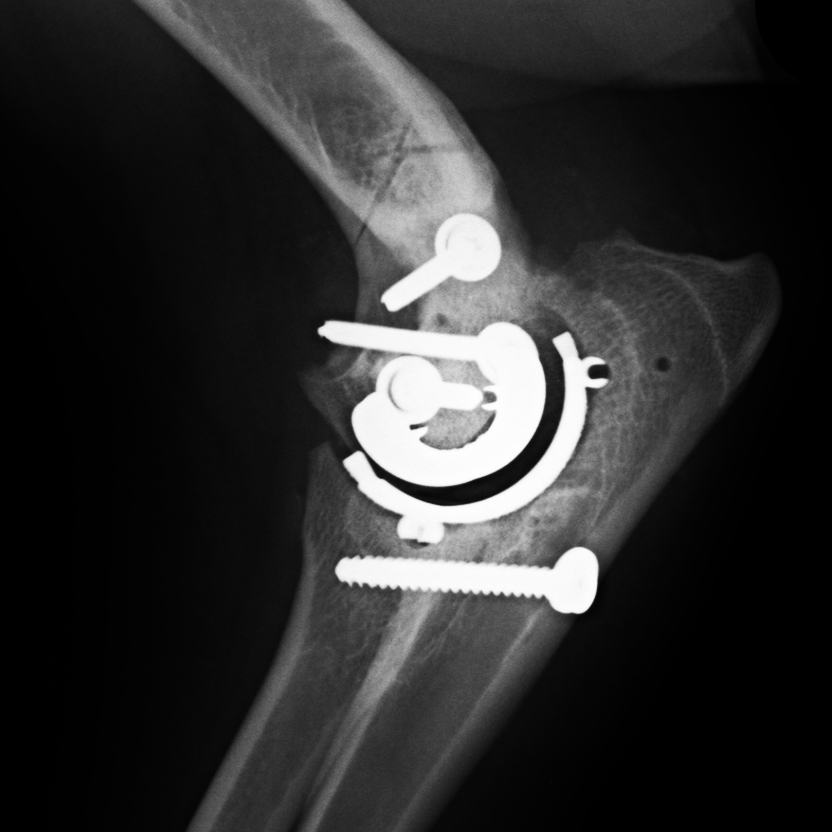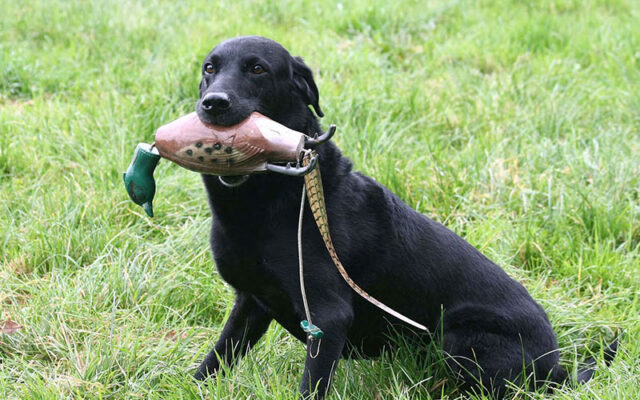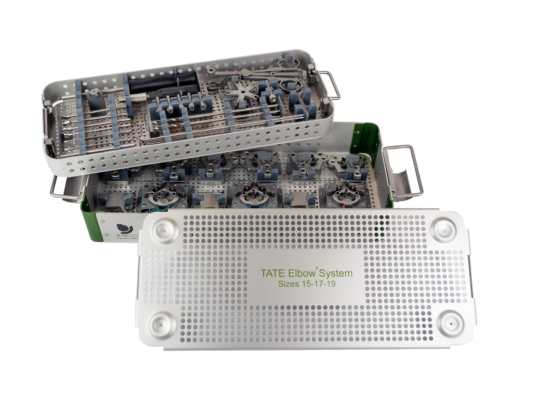INNOVATION • EDUCATION • SUPPORT
The Total Elbow Replacement
Canine TER is a surgical procedure in which the arthritic elbow joint is replaced by a prosthetic. Unlike most prosthesis, which use stemmed cemented components, the TATE Elbow is a resurfacing prosthesis and, as such, requires a less invasive surgical technique for implantation.
The prosthesis is designed to replicate the joint articular surfaces accurately after these have been carefully removed. The purpose of the TATE Elbow procedure is to mimic the fundamental motions of the elbow and eliminate the pain associated with end stage osteoarthritis of the joint.
ELBOW DYSPLASIA
Elbow dysplasia is an abnormal condition involving multiple developmental abnormalities of the elbow joint. These abnormalities initially induce localized lesions where the healthy joint cartilage surfaces are eroded.
SIGNS of elbow dysplasia may be subtle early in the disease’s progression, but become much clearer as it develops. Early on, they can include a subtle limp after a bout of exercise. Dogs generally become less active and playful, choosing to lie down more often in an effort to take the weight off their elbows. At a level described as “end stage,” a dog may be reluctant to get up and walk a short distance. At this stage, joint manipulation is usually quite painful and the range of motion of the elbow is considerably limited.
SURGICAL OVERVIEW
Patients are screened before surgery to make sure they do not have problems in other joints of the affected front limb such as the carpus (wrist) or the shoulder. Your veterinary surgeon will also ensure that your dog is healthy, does not have any neurological or medical conditions including chronic infection such as pyoderma.
Once preoperative examinations are completed, radiographs (x-rays) are taken to assess the severity of the elbow problem. If TER is indicated, surgery can be scheduled.
The surgery entails the removal of the damaged articular surface of the humerus, ulna and radius at the elbow.
The Total Elbow Replacement requires special training to be performed reliably.


RECOVERY
TER has been recommended for your dog to alleviate the pain and/or disability associated with end stage elbow osteoarthritis. Your dog has likely undergone other techniques intended to reduce the pain and suffering associated with elbow dysplasia. Your veterinary surgeon is recommending a TER as previous procedures have had little to no success.

The TATE Elbow arthroplasty was developed in an effort to alleviate the pain and suffering associated with canine elbow dysplasia. Through novel ideas and by addressing surgical complications brought to light by previous canine elbow systems, the TATE Elbow has proven to be a minimally invasive surgical option for the veterinary orthopedic surgeon.

The non-cemented TATE Elbow implant is composed of a humeral component, a radioulnar component, and a removable set plate used for insertion and orientation. Once assembled, these components make the Cartridge Implant. Cartridge implants are manufactured in three asymmetric (right and left) implant sizes: 15mm, 17mm, and 19mm.
FREQUENTLY ASKED QUESTIONS
Canine total elbow replacement (TER) is a surgical procedure in which the arthritic elbow joint is replaced by a prosthetic. Unlike most prosthesis, which use stemmed cemented components, the TATE is a resurfacing prosthesis and, as such, requires a less invasive surgical technique for implantation. The prosthesis is designed to replicate the joint articular surfaces accurately after these have been carefully removed. The purpose of the TATE procedure is to mimic the fundamental motions of the elbow and eliminate the pain associated with end stage osteoarthritis of the joint.
TER has been recommended for your dog to alleviate the pain and/or disability associated with end stage elbow osteoarthritis. Your dog has likely undergone other techniques intended to reduce the pain and suffering associated with elbow dysplasia. Your veterinary surgeon is recommending a TER as previous procedures have had little to no success.
Elbow dysplasia is an abnormal condition involving multiple developmental abnormalities of the elbow joint. These abnormalities initially induce localized lesions where the healthy joint cartilage surfaces are eroded. This degenerative process further deteriorates until the articular cartilage has all but disappeared thus resulting in painful direct bone-on-bone contact. Eventually, elbow dysplasia affects the entire joint and is characterized by a limited range of motion as a result of periarticular fibrosis, pain and a proliferation of bone spurs around the joint. Ultimately, this leads to a loss of overall limb use due to pain and joint function. Once this process has begun, there is little that can be done to inhibit its development.
Signs of elbow dysplasia may be subtle early in the disease’s progression, but become much clearer as it develops. Early on, they can include a subtle limp after a bout of exercise. As the disease progresses, dogs generally become less active and playful, choosing to lie down more often in an effort to take the weight off their elbows. At a level described as “end stage,” a dog may be reluctant to get up and walk a short distance. At this stage, joint manipulation is usually quite painful and the range of motion of the elbow is considerably limited.
Patients are screened before surgery to make sure they do not have problems in other joints of the affected front limb such as the carpus (wrist) or the shoulder. Your veterinary surgeon will also ensure that your dog is healthy, does not have any neurological or medical conditions including chronic infection such as pyoderma. Once preoperative examinations are completed, radiographs (x-rays) are taken to assess the severity of the elbow problem. If TER is indicated, surgery can be scheduled.
The surgery entails the removal of the damaged articular surface of the humerus, ulna and radius at the elbow.
Medical management of elbow dysplasia can include optimization of the patient’s body weight, administration of non-steroidal anti-inflammatory drugs (NSAIDs), nutritional supplementation, and implementation of a rehabilitation program.
End stage elbow dysplasia is often an intractable disease. This means that alternatives, such as medical pain management or conventional surgical procedures, have failed and are no longer effective. At that late stage, surgical fusion of the joint (arthrodesis) or amputation of the limb may be last resort options. However, these may be ill-advised when, as it is most often the case, both elbows are arthritic. Fusion of the joint involves the surgical removal of any tissues that may inhibit the joint’s ability to fuse and the application of an internal or external device to lock the joint at a predefined angle. This will cause the bones to grow together resulting in a fused joint. Fusion will likely remove the pain associated with the joint but will likely lead to an abnormal gait as the elbow joint will no longer exist. Amputation is an option if the disease is occurring in only one of the elbow.
TER, like all surgeries, carries a low risk of anesthetic and infection complications. Additional risks include fractures fo the ulna or humerus. These complications, while serious, are limited. Anecdotal reports suggest that the current rate of severe complications with the TATE is less than 7% up to 4 years after surgery.
TER is not performed on dogs with cancer or other major medical problems of higher priority for treatment. Dogs with lameness caused by problems other than elbow pain, including problems affecting the neck, shoulder, carpus, or metacarpals must be carefully evaluated before a TER is performed. Severely overweight dogs should enter a weight management program prior to surgery.
As with all surgical procedures, patient-owners should consult with their veterinary orthopedic surgeon prior to surgery concerning any potential risks associated with surgery.
BioMedtrix Total Joint Replacement implants are available in a wide range of sizes and configurations to address various anatomic morphologies, and are manufactured to precise tolerances to ensure optimal performance and long-term success. The use of BioMedtrix implants in a hybrid configuration with other implant systems has not been validated by BioMedtrix, and may result in implant failure. For specialty cases, custom implants may be designed and produced upon request.
.





